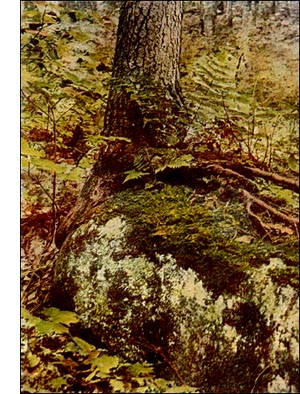Aulacomnium Androgynum Moss
 Aulacomnium androgynum, Schwaegr.
Aulacomnium androgynum, Schwaegr.Habit and habitat.-In dense tufts, green above, rust-brown within, owing to the numerous felted hairs on the stems. Found on bare earth, roots of trees, fissures of rocks, on plains or mountains. A tiny Western humming-bird uses this moss for its nest.
Name.-The specific name, androgynum, hermaphrodite, was given from a mistaken idea that the moss was produced only by asexual methods, that is, by the gemmae, which are not the result of fertilisation. The name is a compound of the Greek for; man, and; woman.
Plant (gametophyte).-Dull-green, stems slender, rarely 1 1/2 inches high, bearing red-brown felt-like filaments, and usually producing slender leafless shoots terminating with round heads of tiny granular bodies (gemmae).
Leaves.-Narrowly taper-pointed; apex toothed; cells small, round, with tiny projections on each face.
Habit of flowering.-Male and female flowers on separate plants (dioicous). Male flower-clusters terminal, bud-like.
Veil (calyptra).-Reaching the middle of the spore-case; long-beaked, split up one side.
Spore-case.-Brown, cylindrical-oblong, furrowed when old; erect, finally horizontal.
Pedicel (seta).- 3/4 of an inch long.
Lid (operculum).-Large, conical.
Annulus. -Compound, rolling back as the lid falls.
Teeth ( peristome). - As in the genus.
Spores.-Mature in summer.
Distribution.-America, Europe.